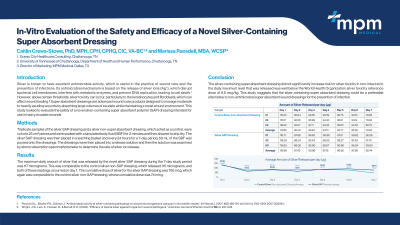Laboratory Research
(LR-013) In-vitro Evaluation of a Novel Silver-containing Super Absorbent Dressing

Methods:
Triplicate samples of the silver SAP and a silver non-super absorbent dressing, which acted as a control, were cut into 25cm2 pieces and were soaked with a simulated body fluid (SBF) for two minutes and then allowed to drip dry. The silver SAP was then placed in a leaching basket and every 24 hours for a 7-day period, 50mL of the SBF was poured onto the dressings. The dressings were then placed into a release solution and then the solution was examined by atomic absorption spectrophotometer to determine the rate of silver ion release.
The maximum daily amount of silver that was released by the novel silver SAP during the 7-day study period was 117 micrograms. This was comparable to the control silver non-SAP dressing, which released 115 micrograms, and both of these readings occurred on day one. The cumulative dose of silver for the silver SAP was 765 mcg, which again was comparable to the control silver non-SAP, whose cumulative dose was 741 mcg. The silver-containing super absorbent dressing did not significantly increase risk for silver toxicity in non-intact skin, with the daily maximum level that was released was well below the World Health Organization silver toxicity reference dose of 6.5mcg/kg. This study suggests that the silver super absorbent dressing could be a preferable alternative to silver non-super absorbent wound dressings for the prevention of infection in wounds with exudate.
Results:
Discussion:

.jpg)